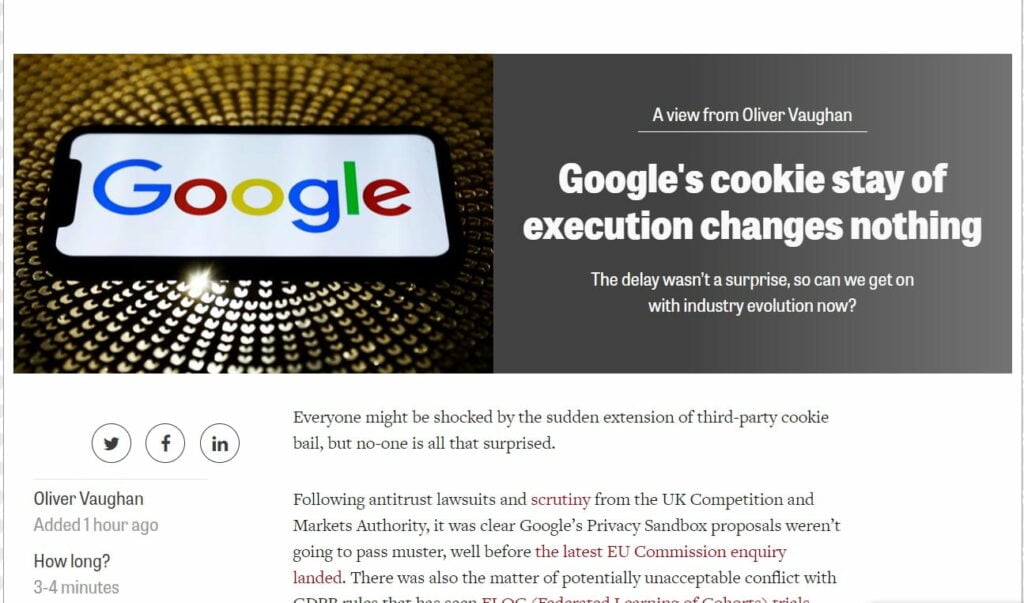
Google’s cookie stay of execution changes nothing
Everyone might be shocked by the sudden extension of third-party cookie bail, but no-one is all that surprised.
Following antitrust lawsuits and scrutiny from the UK Competition and Markets Authority, it was clear Google’s Privacy Sandbox proposals weren’t going to pass muster, well before the latest EU Commission enquiry landed. There was also the matter of potentially unacceptable conflict with GDPR rules that has seen FLOC (Federated Learning of Cohorts) trials delayed in Europe.
Google’s announcement also wasn’t uncharacteristic, with the delay presented as giving the wider online community space to develop better web privacy standards at a responsible pace; instead of buying time to shore up its own preparations. The real wonders lie elsewhere.
First, in the fact that even a major tech powerhouse could misjudge just how deeply third-party cookies are woven into the digital ecosystem. Second, in the mistaken assumption that the pressure to move away from cookies is now off.
Ultimately, the two-year deferral changes nothing. As the privacy-first advertising evolution hurtles full steam ahead, brands and agencies still need to refine first-party data approaches and reduce reliance on lazy cookie-based targeting methods.
Google isn’t the only changemaker
While Google has the clout to cause mass disruption with a one-policy change, it hasn’t driven the sun-setting of third-party cookies single-handedly. Before it opted to end support, concern about the shift in cookie use from communicating user preferences across sites to tracking individual activity had already sparked a global movement of tighter privacy regulations and browser restrictions. The original 2022 deadline only accelerated progress.
This clearly isn’t news, but the point is that cookies have long been on the way out and many players will continue to limit applications alongside other workaround trackers, regardless of Google’s temporary pause — especially the likes of Mozilla and Apple.
It therefore remains crucial for brands and agencies to keep reconfiguring how they create, deliver and measure advertising around alternative, privacy-secure data sources. And for the most part, that means better leveraging first-party data.
Use bonus time wisely
Interest in gathering first-party data was growing prior to Google’s postponed cookie deprecation, with 88% of marketers citing it as a key priority for 2021. With gaining direct consent increasingly important to ensure data access for both brands and agencies, this route has obvious appeal and there is no reason for efforts to stop.
As they look to ramp up collection and implementation, however, it will be important to use the gift of extra time wisely. Instead of rushing to collect as much data as possible, they have room to conduct a full audit: including mapping first-party data assets, and how much spend and performance currently depends on third-party data.
In addition to achieving a granular picture of what audience data they have and whether it’s usable, meticulous assessment will help quickly uncover exactly where adjustment is needed; be that significantly cookie-fuelled attribution practices or re-targeting methods. They may even discover that cookies play a smaller role in some areas than anticipated.
After holes in data stores are identified, the wisest step is maintaining an even focus on plugging immediate gaps and laying the foundations to future-proof success. As well as connecting with consumers to fuel greater trust and data sharing, brands and agencies should harness the extended countdown to build a robust technical infrastructure that will enable them to blend, cleanse and activate incoming first-party data on a consistent basis — such as adopting a customer data platform (CDP) or integrating API connectors with their stack.
Re-prioritising creative connection
The industry tendency to lean heavily on cookies had multiple negative consequences. One of the best known is, of course, fuelling high consumer anxiety that has led four in five to increase online privacy safeguards and a further 40% to delete their browsing history entirely.
Another vital issue is lazy advertising. Brands and agencies have been stuck in a rut, becoming used to mechanical campaign planning and execution where cookies are the main driving force. The ability to layer varied third-party data – covering web activity, location, purchases and interests – and create user-level profiles has made mindless targeting the norm, with cookie insight relied on to ensure data-driven ad relevance and resonance.
Amid the ongoing march away from cookie trackers, these outmoded methods must be retired now – not only after the Google curtain finally falls. Putting stronger emphasis on creative will be paramount to cut through the digital noise and, most critically, earn user confidence and keep the gates to first-party data open.
In particular, brands and agencies must set their sights on using a smart combination of media, data, technology, and powerful creative to win attention and forge meaningful relationships. For instance, that will likely include not only aiming to stimulate interest with interactive formats, rather than invasive targeting, but also tapping multivariate testing to obtain reliable insight about what works and basing creative delivery on performance.
Whatever the actual reasons behind Google’s decision, it doesn’t mean advances so far have been in vain or that they should also come to an abrupt halt. The true waste of time is considering this stay of execution as an excuse to slow down and relax.
Those who thrive in the post-cookie world will be the brands and agencies that continue pushing ahead, honing their strategies, and taking advantage of the delay: re-imagining targeting and measurement to use first-party data and raising the creative bar.
Or in other words: learning from Google’s failed preparation and getting on with it.


